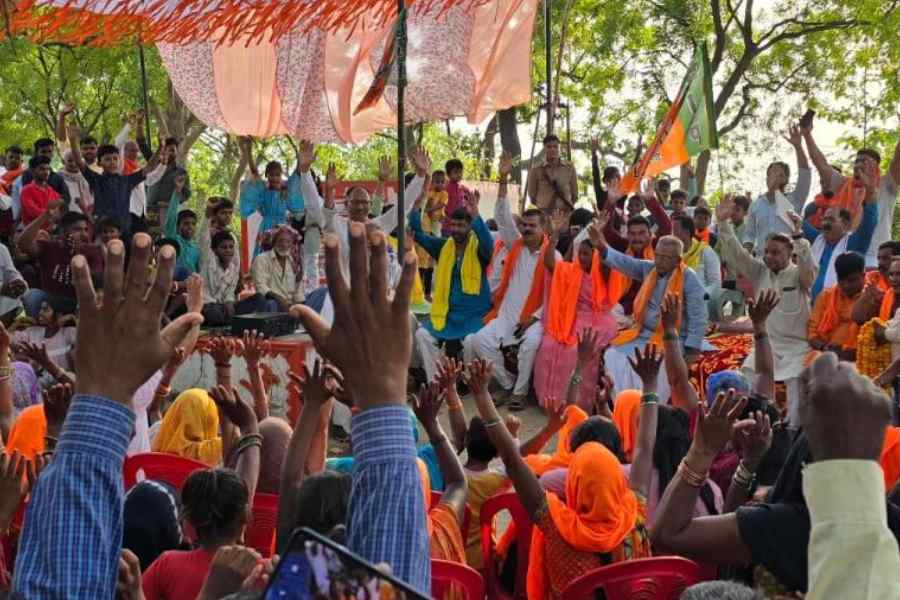Distress is a simmer, anger risen from it can stun you like a slap in the face. “Lagega jhatka, time aagaya vote ka tamacha lagane ka, bhaashan, bhaashan, bhaashan, yahan aadmi bina kaam, bina khaana mar raha hai (A jolt is coming, the time has come for the vote to be used like a slap. Speeches, speeches, speeches. And here people are dying without jobs and food.”
The young man’s eyes were bloodshot with rage, he wouldn’t take names but he left nothing to the imagination about who he was referring to. He wouldn’t give his name either, nor be willing to be photographed. “Photo khichba tuu, aur pela jaai hum, kauno kaaj naikhe (You’ll take the picture and I will take the hammering, no need).”
It took me back to what the kachauri-sabzi outlet owner near the Assi ghat in Varanasi had said just yesterday. “Benaras mein to Modiji ki jeet sunishchit hai, baaki hawa to kharab hai (There’s no threat for Modiji in Varanasi but elsewhere the situation is not the same).”
The angered young man was like a prophecy of the kachauri-seller come alive. We were at a wayside tea and savoury stall not far from Ghazipur, bleached under a 47-degree sun that had beaten life off the roads. A couple of Yadav elders arrived, and ordered tea and sweets resting under a fragment torn off a mosquito net; flies, small and the size of gnats, buzzed all about. The shack owner revealed no interest in the conversation, but the elders soon nodded to the young man’s rant. They would add to it, and they wouldn’t be photographed either. “Why get us into trouble, we are simple folk, no photos. But yes, we will go and vote, that we can say, the vote must speak now.”
Nothing even remotely approaching such rasping resentment has been heard in these parts about Narendra Modi this last decade. It was considered a palpable risk to speak publicly against him. No longer.
East UP, crucible of Modi’s adopted constituency, and fertile turf for the BJP since 2014, is grumbling out its grouses. “How long can one live off lies and more promises? How much more of this mandir-masjid must be fed? Okay, forget the ₹15 lakh in each account, accepted it was a jumla; but what happened to achchhe din?” Gyanesh Prasad, a small Varanasi entrepreneur sums up what many will willingly tell you. “Don’t know what will happen in this election. But things are no longer the same.”
Beyond the abject certainty of the Varanasi outcome, beyond the limits of Modi’s constituency, eastern UP begins to resemble an enmeshed battleground, no longer in the sweep of a juggernaut, no longer under the spell of a cult.
In the two previous elections in UP — as well as in neighbouring Bihar — Modi played an overarching interventionist, able to overcome the deficiencies of BJP candidates by sheer dint of being Modi.
The Modi name was the currency of victory. It could neutralise local anti-incumbency, inject vigour into a weak candidate, demoralise the Opposition. The BJP voters were seldom voting the party or the candidate; they were voting “Modiji”. That phenomenon has lost wind in its sails.
You head towards Jaunpur or Bhadohi, you head towards Mirzapur and beyond, you head towards Chandauli or Ghazipur — the pattern everywhere is broadly the same; robust rival caste and creed formations locked in an intense smash-and-grab war. After two high-voltage “Modi-Modi!” Lok Sabha elections, this one is back to being a classic “sameekaran” (caste combination-alignment) affair.
As you leave Varanasi and enter the rural dust bowl that surrounds it, you are likely to sense the Modi decibel falling away and the clamour of a more even contest beginning to make itself heard. You hear Modi-Modi but more often as an object of anger rather than adulation. You hear “contest hai”; you hear “phansa hua hai”; you hear “kaante ki takkar”. You don’t hear “Modi hi mudda hai” (Modi is the issue). You don’t hear the refrain that Modi alone is enough to swing it.










